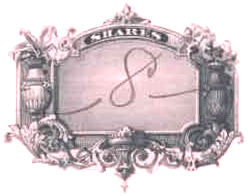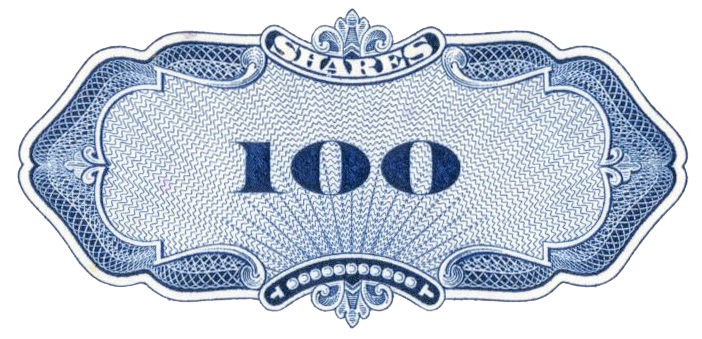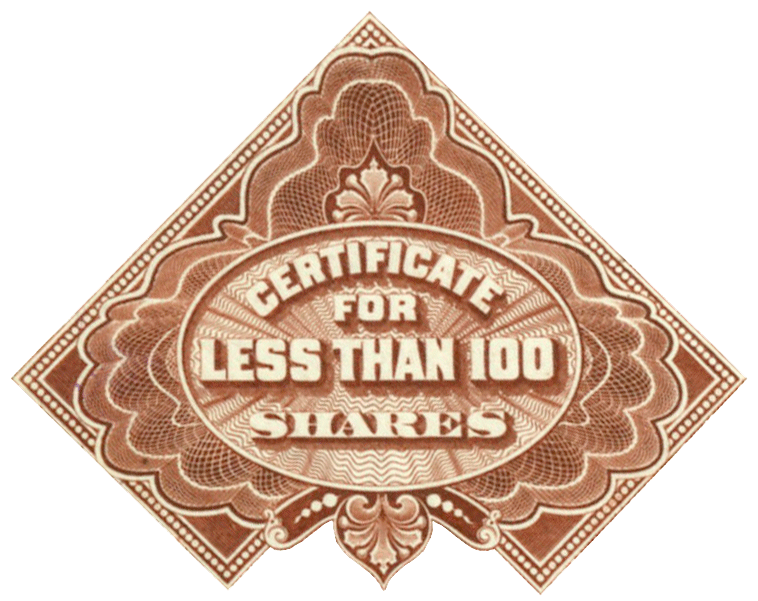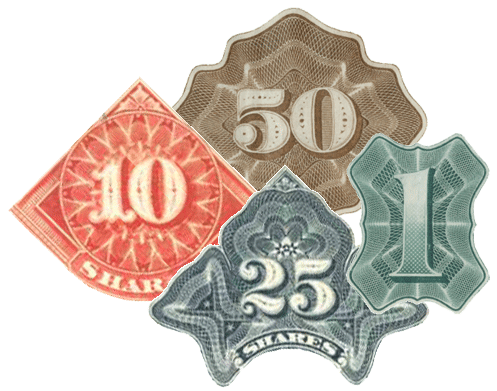Typical denominations seen on stock certificates
Odd-shares

Three quarters of all stock certificates encountered in the railroad and coal specialties are odd-share certificates. Most share values were completed by hand with quill or nib pens even after typewriters were available.

Filling share values by hand lasted the entire period of paper certificate issuance. Some handwriting was beautiful and consistent over years. Some quite the opposite. Of course, human error is a constant, so partially issued certificates are relatively common. Typewriters helped readability, but they never eliminated mistakes.
Mistakes aside, hand-filling certificates incurred on-going labor costs. There was also the issue of alteration that could be accomplished by removing pen strokes and raising share values. Intercepting alterations and counterfeits also had its cost.
Pre-printed denominations

One of the ways to counter those costly problems was to pre-print share values. While we probably will never learn the earliest efforts, we know The Western Jamaica Connecting Railway created 10- and 20-share pre-printed certificates in 1845. It seems reasonable to assume that pre-printed 1-share certificates were among the earliest experiments, but none are currently known before the 1850s. Stock certificates with 2-, 5- and 50-share denominations also began to appear during that same period.
100-shares

Because of high inflation, is possible that 100-share certificates were used during the Civil War. The first certificates currently confirmed to show pre-printed 100-share values came from The Colorado & Southern Railway Co. in 1869. Pre-printed 100-share certificates are the second most popular denomination in terms of identified varieties (12.5%)
Less than 100 shares

It seems possible that "less than one hundred shares" certificates appeared concurrently with 100-shares, but the earliest recorded examples was issued by The International Railroad Co. and dated 1871. Those kinds of certificates, did not necessarily diminish labor costs but they became and remained very popular. About 9% of all surviving collectible certificates are <100-share certificates which makes them the third most popular denomination. A large percentage of <100-share certificates are accompanied by punch panels, normally printed in the right-hand border.
Other denominations
Approximately 60 denominations in various currencies have been identified so far on North American railroad certificates. Another 20 denominations could be counted if one considered fractional share certificates (less than 1 share.) Over a third of the "other denominations" are very rare, often represented by only single varieties and frequently by single certificates.

At present, the percentages of varieties represented by the top seven most common denominations (odd-, <100-, 1-, 10-, 50-, 100- and <1,000-shares) almost perfectly mirror reported populations.
Hand-written denominations.
Initially, company clerks hand-wrote buyers’ names and numbers of shares on every certificate issued. Denominations ranged from partial shares to millions of shares. In large companies, that hand work was expensive. Eventually companies reasoned that pre-printed denominations would save time and wages.
Pre-printed denominations.
The earliest surviving stock certificates with pre-printed denominations date from about 1870. That year, both the Milwaukee & St. Paul Railroad and the International & Great Northern Railroad issued certificates pre-printed with 100-share denominations. A few more companies issued 100-share certificates through the 1870s, but they were not used in quantity until the 1880s.


Certificates specifically marked as 'less than one hundred shares' also appeared as early as 1870. 'Less than 100 shares' certificates were in widespread use by the mid-1880s.
Generally, "less than one hundred share" certificates included "counters" somewhere on the certificate. Counters (also known as "punch panels") were normally located within the right margin. They were meant to be punched to correspond to the number of shares purchased. Occasionally, counters were placed along the bottom margin. In some cases, counters included as many as five columns of numbers, enabling companies to issue as many as 99,999 shares.
The illustration at right shows a counter punched to represent eight shares.
Currently, the earliest 10-share stock certificate seems to have appeared about 1873. Jay Gould’s heavy selling and stock manipulation forced the introduction of huge quantities of pre-printed 10-share certificates for the Missouri Kansas & Texas line in 1880. About five years later, companies began experimenting with 500-share certificates, but they found little need for certificates with such large-denominations.
Oddball denominations

Other 'oddball' denominations have appeared from time to time, but except for 50-share certificates, none ever caught on. At the other end of the spectrum, a handful of 1,000-, 5,000-, and 10,000-share certificates are also known. The highest denominations in the database are currently the <1,000,000-share certificates used by the Union Pacific Corp. into the 1970s.